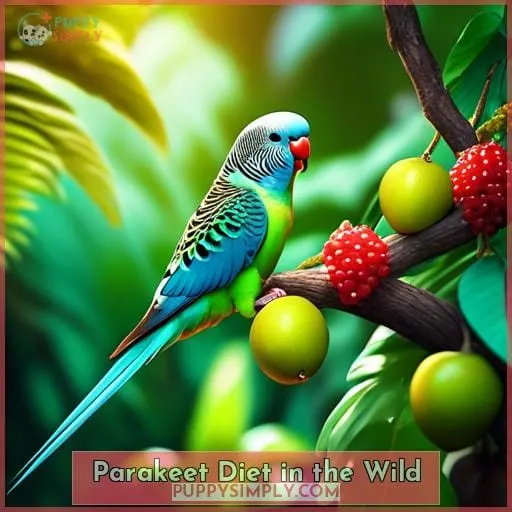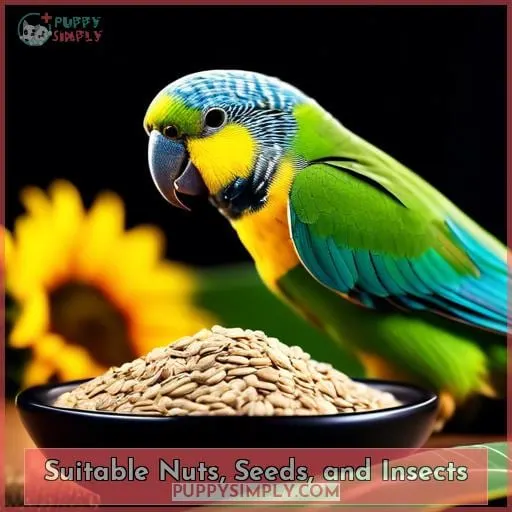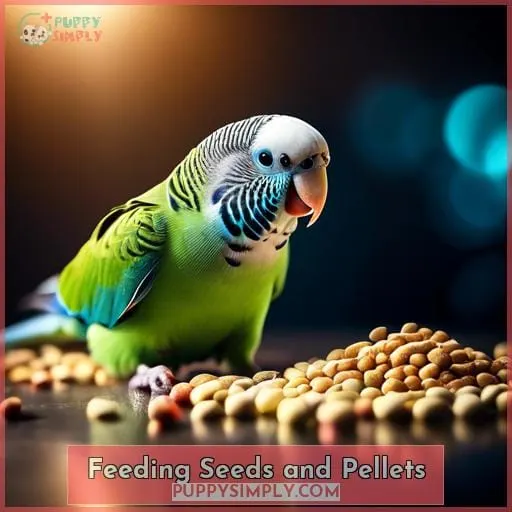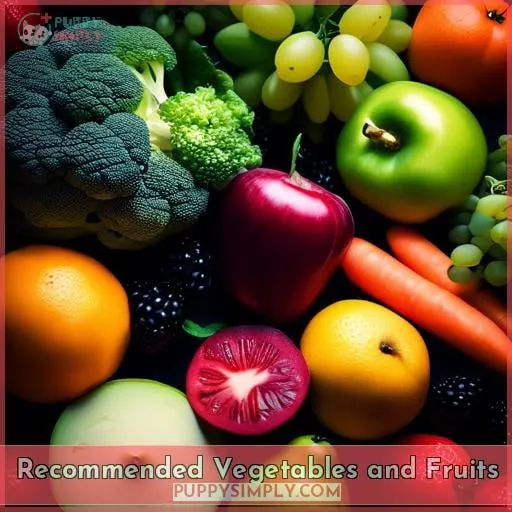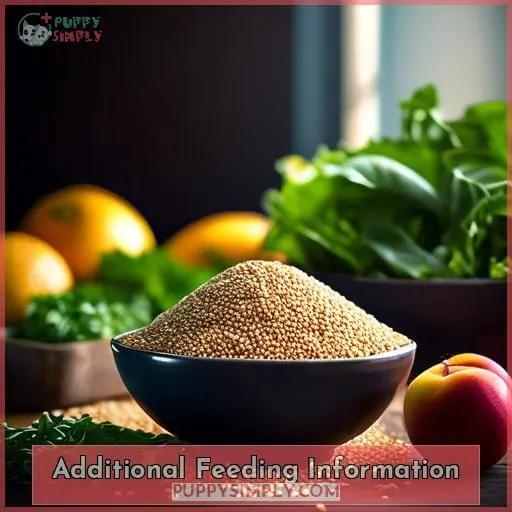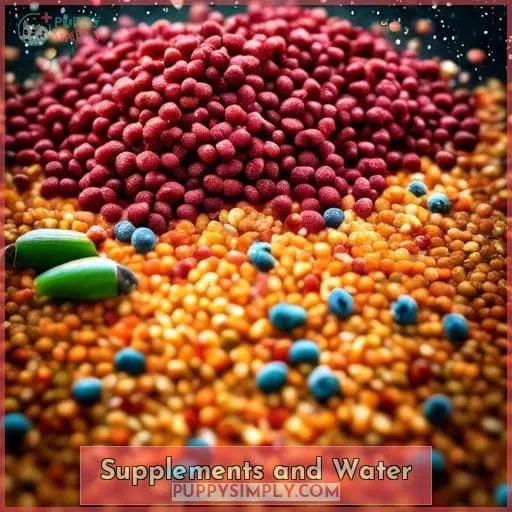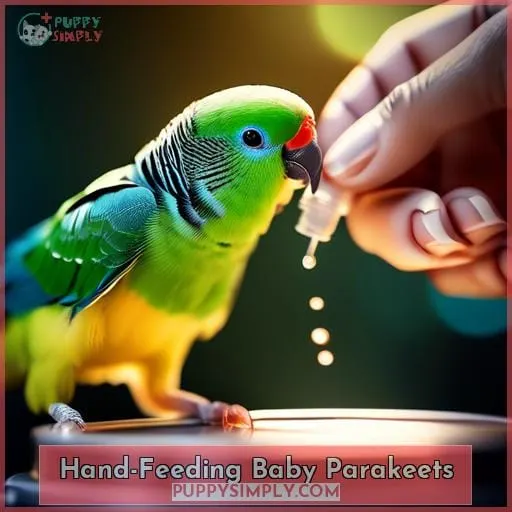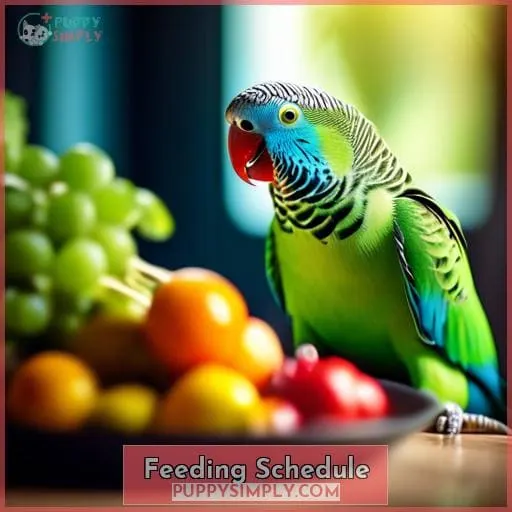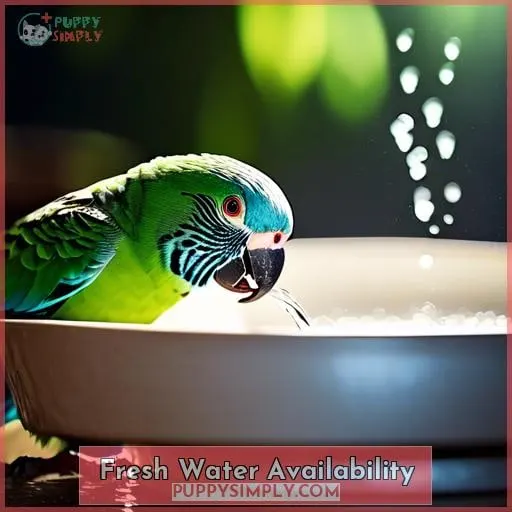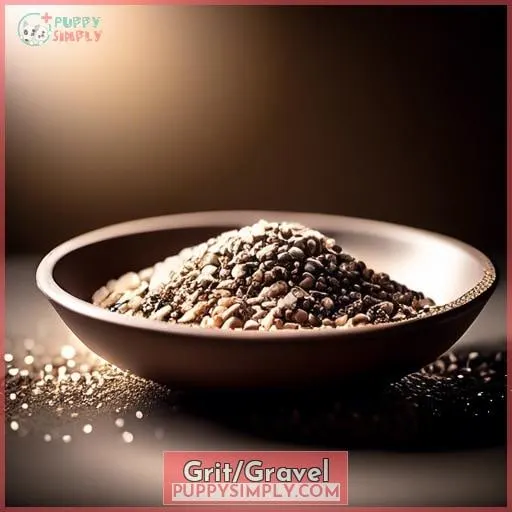This site is supported by our readers. We may earn a commission, at no cost to you, if you purchase through links.
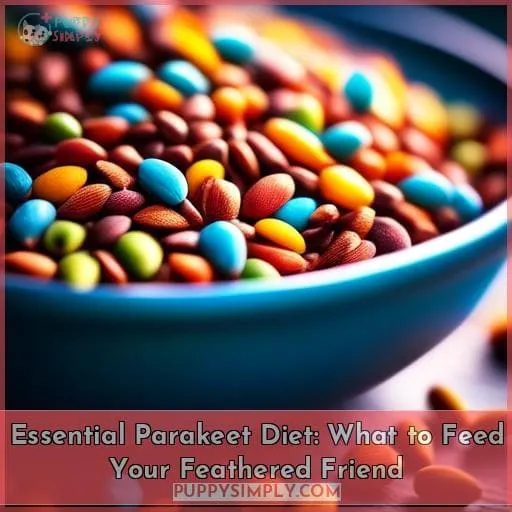 Did you know that parakeets are known for their vibrant colors, playful personalities, and ability to mimic human speech?
Did you know that parakeets are known for their vibrant colors, playful personalities, and ability to mimic human speech?
As a parakeet owner, you’ll want to ensure you’re feeding your feathered friend a diet that meets their nutritional needs.
In this article, we’ll delve into the world of parakeet nutrition, exploring:
- What they typically eat in the wild
- Suitable nuts, seeds, and insects
- Feeding seeds and pellets
- Recommended vegetables and fruits
- Additional feeding information
- Supplements
- Water
We’ll also discuss:
- Hand-feeding baby parakeets
- Feeding schedules
- The importance of fresh water availability
Table Of Contents
- Key Takeaways
- Parakeet Diet in the Wild
- Suitable Nuts, Seeds, and Insects
- Feeding Seeds and Pellets
- Recommended Vegetables and Fruits
- Additional Feeding Information
- Supplements and Water
- Hand-Feeding Baby Parakeets
- Feeding Schedule
- Fresh Water Availability
- Grit/Gravel
- Frequently Asked Questions (FAQs)
- Conclusion
Key Takeaways
]
Parakeet Diet in the Wild
You’ll find parakeets in the wild primarily eating seeds and grasses.
Their diet also includes fruits, nectar, insects, larvae, tree seeds, fruits, berries, buds, and bark.
This varied diet reflects their opportunistic foraging behavior, allowing them to adapt to changing environmental conditions and seasonal variations.
Their beaks and digestive systems have evolved to efficiently process this diverse range of food items.
By consuming a variety of foods, parakeets obtain the necessary nutrients for growth, reproduction, and overall well-being.
Their foraging behavior, such as digging up various food items, illustrates their remarkable adaptations to their natural environment.
Understanding their wild diet provides valuable insights into their nutritional needs in captivity, helping us provide them with a balanced and wholesome diet.
Suitable Nuts, Seeds, and Insects
Parakeets can be fed a variety of nuts, seeds, and insects.
Suitable nuts include:
- Acorns
- Brazil nuts
- Hazelnuts
- Horse chestnuts
- Monkey nuts
- Peanuts
- Pistachios
- Pumpkin seeds
- Sunflower seeds
- Walnuts
Ideal seeds include:
- Sunflower seeds
- Mung seeds
Appropriate insects include:
- Mealworms
Nuts
- Start with the nuts you’re likely to find in your pantry: almonds, walnuts, and peanuts.
- These provide a nutritional balance, aiding healthy snacking.
- Avoid cashews and macadamias due to nut allergies.
- Mix nuts with seeds for a varied treat, excluding lories and lorikeet mixes.
Seeds
- Sunflower seeds: rich in oils and protein.
- Mung seeds: high in protein and fiber.
- Hemp seeds: contain omega-3 fatty acids.
- Flax seeds: rich in omega-3 fatty acids.
Insects
If you want to add variety to your parakeet’s diet, consider offering live or dried mealworms as a source of protein.
Insect Nutrition
Rich in protein
Good source of calcium
Contains essential fatty acids
Feeding Seeds and Pellets
You can feed your parakeet most small bird seeds and pellets, except lories and lorikeet mixes.
Cockatiel, budgie, canary, and finch mixes are suitable, though the latter three are small.
Avoid large parrot pellets, as they’re too big for parakeets.
Ensure food items are appropriate for your bird’s size.
Parakeets love chewing wood branches and eating flowers.
Homemade treats can provide nutritional balance and dietary enrichment.
Offer seasonal foods like berries and fresh herbs.
Avoid grit, as it’s unnecessary if you provide foraging opportunities and chewable branches.
Never give your parakeet human food, as it can be toxic.
Tree seeds, fruits, and berries are natural parts of a parakeet’s diet.
Recommended Vegetables and Fruits
You’ll want to feed your parakeet a variety of fresh vegetables and fruits, which should comprise 5-10% of their diet.
These foods provide essential vitamins and minerals that are crucial for your parakeet’s health.
Some safe vegetables include asparagus, carrots, zucchini, and squash.
Some safe fruits include tangerines, apples, bananas, and mango.
Vegetables
The article recommends a variety of vegetables to incorporate into your parakeet’s diet:
- Broccoli
- Brussels sprouts
- Carrots
- Celery
- Cucumber
These herbaceous delights provide essential vitamins, minerals, and fiber, promoting overall well-being.
Additionally, small quantities of fruits like apples, bananas, and berries can be offered as occasional treats, providing a sweet and juicy contrast to their regular diet.
Fruits
In addition to vegetables, offer your parakeet a variety of fruits rich in essential vitamins and minerals.
Seasonal fruit varieties like tangerines, apples, bananas, mango, and coconut are excellent choices.
Remember to remove seeds and pits to prevent choking hazards.
Balance your parakeet’s nutritional needs by offering fruits sparingly as treats.
Use homemade treat recipes to introduce new flavors while avoiding harmful foods.
Additional Feeding Information
- Feed your parakeet 1/2 to 1 teaspoon of food per day if it’s small, up to 1 tablespoon if it’s larger.
- Cut vegetables into small pieces or shred them.
- Offer fruits sparingly because of their high sugar content.
- Hang sprays of berries, flowers, or twigs in the cage for enrichment.
Feed Amounts
Feed your parakeet 1/2 to 1 teaspoon daily for small birds, up to 1 tablespoon for larger species.
Maintain nutritional balance with dietary variety; offer optimal treats sparingly; provide water for hydration daily; administer health supplements as needed.
Cutting Vegetables
When feeding your parakeet vegetables, always cut them into small pieces to make them easier to eat.
Veggie Variety:
Offer a diverse selection of vegetables to ensure a balanced diet.
Knife Skills:
Use a sharp knife to create bite-sized pieces that are easy to swallow.
Colorful Plates:
Arrange vegetables in a visually appealing manner to entice your parakeet.
Cooking Techniques:
Steam or lightly cook vegetables to preserve nutrients and enhance flavor.
Offering Fruits
- Cut fruits into bite-sized pieces, as whole fruits pose a choking hazard.
- Offer seasonal fruit varieties sparingly due to their high sugar content.
- Use fruit as training treats or enrichment ideas to promote mental stimulation and bonding.
Enrichment
Hang sprays of berries, flowers, or twigs in your parakeet’s cage for added enrichment and mental stimulation.
Rotate toys regularly to prevent boredom.
DIY puzzles challenge and engage your parakeet’s mind.
Vary cage setups to encourage exploration.
Engage in interactive playtime activities to bond with your feathered friend.
Supplements and Water
Supplements may be needed if you own a parakeet with specific health needs or deficiencies.
Always provide clean, fresh water daily, and clean the waterer regularly.
Parakeets shouldn’t drink anything other than water, including soda, beer, or alcoholic beverages.
Supplements
Your parakeet’s diet should provide all the nutrients it needs, so supplements aren’t typically necessary.
However, if your bird has specific health needs or deficiencies, a veterinarian may recommend supplements.
When considering supplements, remember:
- Choose supplements specifically formulated for parakeets.
- Ensure the supplement doesn’t upset your bird’s nutritional balance.
- Consult a veterinarian before giving supplements to a bird with health issues.
- Offer a varied diet to minimize the need for supplements.
- Provide clean, fresh water daily.
Supplementing responsibly can support your parakeet’s well-being.
Water
Besides supplements, you should also provide your parakeet with clean, fresh water daily.
Ensure the water is free of contaminants and impurities to prevent illness.
Parakeets rely on water for hydration, digestion, and nutrient absorption.
Encourage your parakeet to drink by placing the water dish near its food bowl and cleaning it regularly to maintain water quality.
Hand-Feeding Baby Parakeets
Although supplements aren’t necessary with a balanced diet, hand-feeding baby parakeets is a specialized task best left to experienced individuals.
The delicate nutritional requirements of baby parakeets demand precise knowledge of their developmental challenges and specialized techniques.
Nutrient Requirements:
- Baby parakeets have unique nutrient requirements for proper growth and development.
- Their diet must be rich in proteins, carbohydrates, fats, vitamins, and minerals.
- Specialized formulas are available to meet these specific needs.
Developmental Challenges:
- Hand-feeding baby parakeets requires understanding their developmental challenges.
- They’re prone to dehydration, hypothermia, and crop stasis.
- Careful attention must be paid to feeding frequency, temperature, and proper formula consistency.
Parental Involvement:
- Parental involvement plays a crucial role in the hand-feeding process.
- Observing parental feeding techniques can provide valuable insights into the natural feeding behavior of baby parakeets.
- This knowledge can be applied to hand-feeding, ensuring the baby receives adequate nourishment.
Feeding Schedule
Once you’ve determined the ideal diet for your parakeet, stick to a twice-a-day feeding schedule. This regularity instills a sense of routine and security in your feathered companion.
Offer fresh food and water in the morning, and replenish their supply in the evening.
Remove uneaten food to prevent spoilage and maintain a clean environment.
Variety is key to your parakeet’s nutritional balance. Rotate different food items within each meal to ensure they’re getting a comprehensive range of nutrients.
Introduce new foods gradually to avoid digestive upset.
Treats can be offered sparingly as positive reinforcement during training or as a special reward.
Choose healthy options like millet sprays, cooked whole-grain pasta, or brown rice.
Avoid sugary treats and processed foods, which can lead to health issues.
Hydration is crucial for your parakeet’s well-being. Provide fresh, clean water daily and change it regularly to prevent contamination.
You can also offer occasional baths to help your parakeet keep its feathers clean and healthy.
Interactive toys can stimulate your parakeet’s mind and provide behavioral enrichment. Puzzle feeders, foraging toys, and interactive perches encourage natural foraging behavior and mental agility.
Fresh Water Availability
Beyond the solid nourishment of seeds, pellets, and fresh produce, your parakeet’s well-being hinges on its access to clean, fresh water.
Hydration is paramount for various bodily functions, including digestion, circulation, and temperature regulation.
To ensure your feathered friend’s optimal health, provide a dedicated water bowl or bottle within their cage. Opt for a design that’s easily accessible, doesn’t tip over, and allows for a clear view of the water level.
Change the water daily, preferably twice if possible, to prevent bacterial growth and maintain its palatability.
Keep an eye on your parakeet’s drinking habits. If you notice a sudden change in their water consumption, it could signal an underlying health issue.
In addition to fresh water, you can offer your parakeet wet food options like fruits and vegetables with high water content, such as watermelon or cucumber.
Grit/Gravel
You don’t need grit or gravel for your parakeet if you offer chewable branches and foraging opportunities. These provide the necessary roughage and grit for proper digestion, mimicking their natural diet in the wild.
Their wild diet includes foraging for seeds, fruits, and insects, which provide essential grit and roughage.
Grit aids in the grinding of food, facilitating digestion and nutrient absorption.
Providing chewable branches and foraging opportunities encourages natural behaviors and promotes overall well-being.
A varied diet rich in fruits, vegetables, and pellets also contributes to optimal digestion and overall health.
Frequently Asked Questions (FAQs)
How much food should I feed my parakeet daily?
Measure 1/2 to 1 teaspoon of food daily for petite parakeets, up to 1 tablespoon for larger species.
Chop vegetables small or shred them.
Dole out fruits sparingly due to their sugar content.
Can I feed my parakeet human food?
Absolutely!
Treat your parakeet to human food delights, but do so judiciously.
How often should I give my parakeet treats?
Treats should be given sparingly, no more than once or twice a week.
Excessive treats can lead to:
- Obesity
- Nutritional imbalances
- Decreased appetite for essential foods
What are some signs that my parakeet is not getting enough nutrients?
If your parakeet displays dull feathers, low energy levels, or poor appetite, it might be experiencing nutritional deficiencies.
Monitor its diet and consult a veterinarian for guidance on ensuring a balanced nutritional intake.
How can I encourage my parakeet to eat a variety of foods?
To entice your parakeet’s palate, create a vibrant, edible landscape.
With an array of fresh fruits, vegetables, and wholesome seeds, this gastronomic adventure will awaken their taste buds and nurture their well-being.
Conclusion
As you embark on this journey of providing your parakeet with a nutritious and balanced diet, remember that you hold the key to their well-being.
Your dedication to understanding their dietary needs and offering a variety of wholesome foods ensures their vibrant colors, playful personalities, and ability to mimic human speech continue to shine.
With your care and attention, you’ll witness the remarkable bond that forms between you and your feathered friend, making every moment together a cherished memory.

